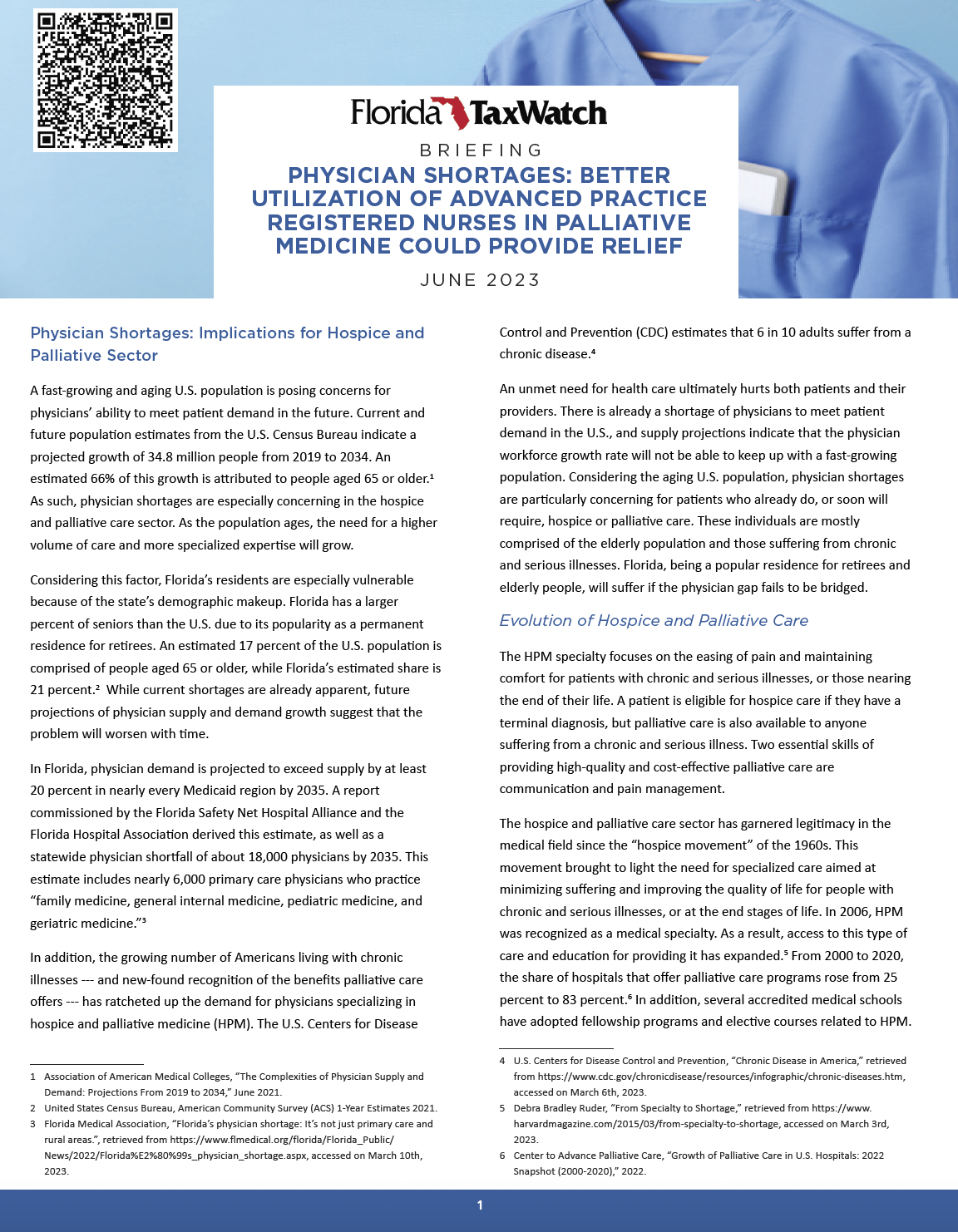Physician Shortages: Better Utilization of Advanced Practice Registered Nurses in Palliative Medicine Could Provide Relief - Revised
 Considering this factor, Florida’s residents are especially vulnerable because of the state’s demographic makeup. Florida has a larger percent of seniors than the U.S. due to its popularity as a permanent residence for retirees. An estimated 17 percent of the U.S. population is comprised of people aged 65 or older, while Florida’s estimated share is 21 percent. While current shortages are already apparent, future projections of physician supply and demand growth suggest that the problem will worsen with time. As of 2019, roughly 13,700 primary care physicians were needed to eliminate the shortage, but the Association of American Medical Colleges (AAMC) projects a shortage of anywhere between 17,000 and 48,000 by 2034.
Considering this factor, Florida’s residents are especially vulnerable because of the state’s demographic makeup. Florida has a larger percent of seniors than the U.S. due to its popularity as a permanent residence for retirees. An estimated 17 percent of the U.S. population is comprised of people aged 65 or older, while Florida’s estimated share is 21 percent. While current shortages are already apparent, future projections of physician supply and demand growth suggest that the problem will worsen with time. As of 2019, roughly 13,700 primary care physicians were needed to eliminate the shortage, but the Association of American Medical Colleges (AAMC) projects a shortage of anywhere between 17,000 and 48,000 by 2034.
In Florida, physician demand is projected to exceed supply by at least 20 percent in nearly every Medicaid region by 2035. A report commissioned by the Florida Safety Net Hospital Alliance and the Florida Hospital Association derived this estimate, as well as a statewide physician shortfall of about 18,000 physicians by 2035. This estimate includes nearly 6,000 primary care physicians who practice “family medicine, general internal medicine, pediatric medicine, and geriatric medicine.”
In addition, the growing number of Americans living with chronic illnesses --- and new-found recognition of the benefits palliative care offers --- has ratcheted up the demand for physicians specializing in hospice and palliative medicine (HPM). The U.S. Centers for Disease Control and Prevention (CDC) estimates that 6 in 10 adults suffer from a chronic disease.
An unmet need for health care ultimately hurts both patients and their providers. There is already a shortage of physicians to meet patient demand in the U.S., and supply projections indicate that the physician workforce growth rate will not be able to keep up with a fast-growing population. Considering the aging U.S. population, physician shortages are particularly concerning for patients who already do, or soon will require, hospice or palliative care. These individuals are mostly comprised of the elderly population and those suffering from chronic and serious illnesses. Florida, being a popular residence for retirees and elderly people, will suffer if the physician gap fails to be bridged.
Fully utilizing the APRN workforce has the potential to significantly mitigate current and future physician shortage issues, including limited access to health care and worsening patient outcomes due to physician burnout. This solution is particularly important to consider in the case of hospice and palliative care facilities, where an unmet demand for care has persisted. These needs will only continue growing amid an aging population. APRNs in Florida are currently prohibited from performing some largely administrative, but essential tasks in hospice and palliative care due to the omission of this field of medicine in Florida Statutes. There are three primary reasons why the Autonomous Practice Act should be amended to include hospice and palliative care, granting APRNs more autonomy in palliative care settings:
1. The APRN workforce is expanding.The draw of this rewarding profession is gaining traction, and the current high-growth status of the workforce is predicted to continue in the next decade. In this, there is potential to improve patient access to all types of health care, especially palliative care. With an aging population, undoubtedly more Americans will need specialized hospice and palliative care in the coming years. Future projections of physician supply alone do not indicate this demand could be met, but supplementing physicians with APRNs on medical teams would begin to address shortages.
2. Utilizing Nurse Practitioners (NPs) is associated with lower costs of care. The education, compensation, and use of costly procedures in practice is lower among NPs than that of physicians. Cost analyses indicate that medical facilities can achieve lower expenditures from utilizing more NPs and PAs. With current average salary estimates, a practice could employ two NPs for the cost of hiring one physician. Additionally, NP-led practices conduct fewer costly procedures than physician-led practices, while achieving the same or substantially similar patient outcomes.
3. The education and training of APRNs fully prepares them to perform these tasks. A licensed APRN must earn a master’s or doctoral degree in their chosen field of medicine, and then acquire a certification in that field. APRNs are trained in the nursing model, but also receive advanced practice training that combines the teachings of nursing with curriculum from the physician model. The combination of these skills, and especially the patient-centered nursing approach APRNs learn, fully qualifies them to perform the duties that Florida law currently precludes.
For these reasons, Florida TaxWatch recommends that section 464.0123(3) of Florida Statutes be amended so that APRNs’ autonomous practice authority in primary care is extended to hospice and palliative care. This inclusion will simply allow APRNs already performing certain duties in primary care practice to then utilize these skills in a palliative care setting. This is a step towards addressing physician shortage problems in Florida. Taking measures such as this one will improve patient access to hospice and palliative care, supporting a higher quality of life for Floridians with chronic and serious illness or at the end of life.